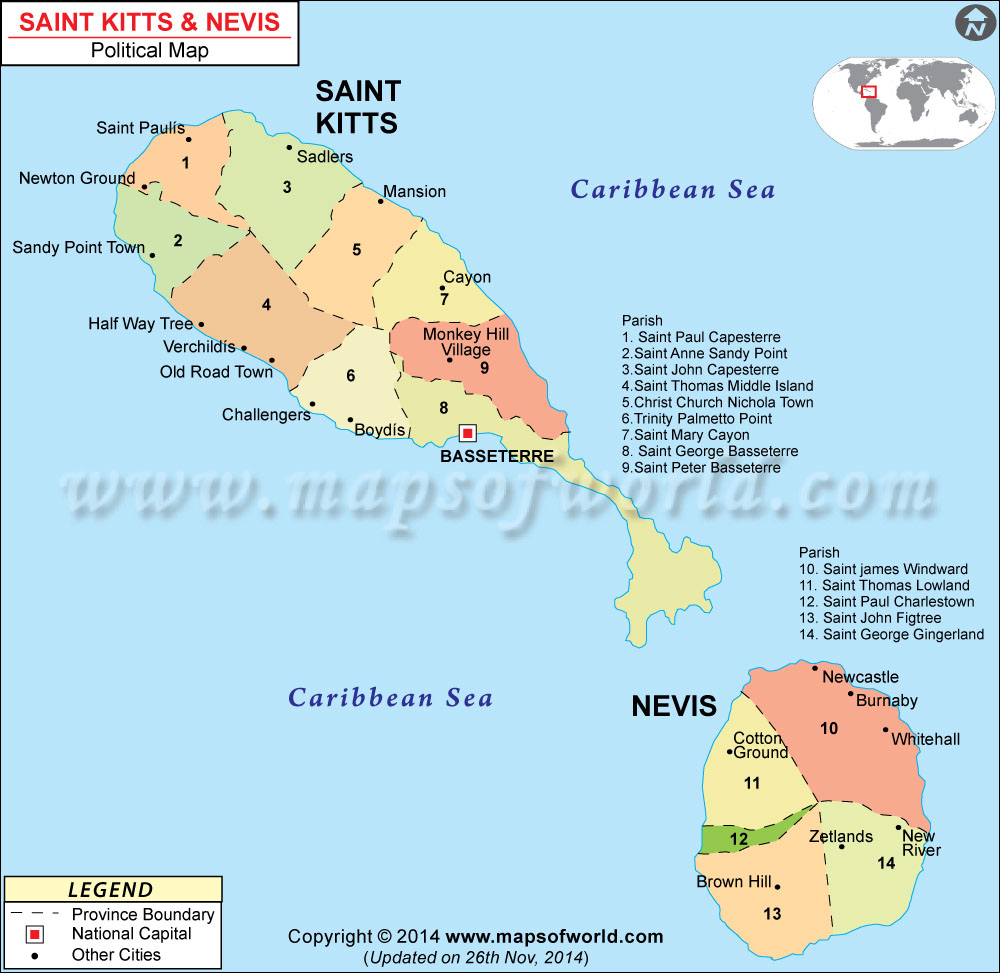St. Kitts and Nevis Map

- Neighboring Countries - Antigua, Dominica
- Continent And Regions - North America Map, Americas Map
- Other St Kitts And Nevis Maps - Where is St Kitts And Nevis, St Kitts And Nevis Blank Map, St Kitts And Nevis Road Map, St Kitts And Nevis Rail Map, St Kitts And Nevis Cities Map, St Kitts And Nevis Flag
About St. Kitts and Nevis
Explore this St. Kitts and Nevis map to learn everything you want to know about this country. Learn about St. Kitts and Nevis location on the world map, official symbol, flag, geography, climate, postal/area/zip codes, time zones, etc. Check out St. Kitts and Nevis history, significant states, provinces/districts, & cities, most popular travel destinations and attractions, the capital city’s location, facts and trivia, and many more.
| Full name | Federation of Saint Kitts and Nevis. |
| Capital City | Basseterre. |
| Language | English and other local dialects. |
| Currency | Eastern Caribbean Dollar. |
| Religion | Anglican, Methodist, Roman Catholic, Baptist, Adventist, Moravian and Jehovah’s Witness. |
| National Anthem | “Oh Land of Beauty”. |
| Newspaper | Leewards Times, St. Kitts Nevis Observer, Democrat, Labour Spokesman and Sun St. Kitts Nevis. |
| Places to Visit | Basseterre, Charlestown, Botanical Gardens of Nevis, Brimstone Hill Fortress National Park and Museum of Nevis History. |
| Transport | Airways: flights are available only from the US. However, there are flight options from the other caribbean nations. American Airlines has daily flights services; Waterways: yaht and cruise ships come to Basseterre and Charlestown. |
| Shopping | carvings in wood and stone, batik, tapestries and wall hangings, coconut crafts, leather art, local textiles, stamps and Nevis’ hot pepper sauce. |
Climate of Saint Kitts and Nevis : the island-nation of Saint Kitts and Nevis has a pleasant and warm Caribbean climate. Sometimes it can get unduly hot too, but this heat is infallibly tempered by the regular trade winds. The winters are extremely pleasant and dry; while most of the rainfall is experiences in the summers. The summer months last between May and October, while winters are between November and April.
Flora and Fauna of Saint Kitts and Nevis :
- Flora : flora in the Saint Kitts and Nevis islands comprises of a tropical heaven. The tropical variety includes hardwoods as well as flowers. Some of the popular varieties are coconut palms, palmettos, cabbage palms, gumlin, burrwood, sweetwood, mosses, acacia, ferns, pear cactus, white cedar, blackmast, loblolly, Lemon trees, and tamarind. Popular flowering varieties include poincianas, bougainvillea and hibiscus.
- Fauna : fauna in the Saint Kitts and Nevis islands is not as various as the islands’ plant life. However, there are some rare varieties that can be sighted in the islands. The black-faced vervet monkeys are the common land fauna. The marine fauna is more exotic with spiny lobster, queen conch, hawksbill turtles and green sea turtles forming the list.